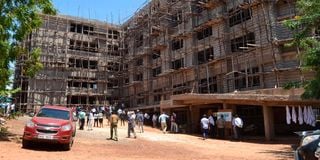Premium
Kenyans paying dearly for Sh2 trillion stalled projects

Stalled Sh400 million Tharaka-Nithi County executive offices building which started in 2015.
The Kenyan taxpayer could have lost more than Sh2 trillion pumped into poorly planned and funded projects, that have seen four successive governments litter the country with white elephants.
Different reports indicate that the cost of stalled public projects ranges anywhere between Sh2.3 trillion and Sh9 trillion, a situation that leaves Kenyans underserved in their education, health, security and infrastructural needs, paying painfully for public agencies’ wrong investment decisions.
The conflicting numbers from various reports on the actual value of stalled projects also raise more questions about the losses suffered by the taxpayer.
A Sunday Nation analysis now exposes the impact hundreds of these stalled public projects across the country — mainly funded by taxes and borrowed money — have caused citizens, hindering service delivery in almost all sectors.
It is a case of bad, and selfish, decisions made by officers entrusted with the management of public money currently and in the past, whose cost is now being paid by innocent citizens, who have been left to suffer poor public services.
Some of the projects were initiated over 35 years ago — before nearly two-thirds of Kenyans were born — but remain under implementation to date, only on paper.
After reviewing hundreds of documents from different government agencies including Parliament, the Treasury, the Office of the Auditor-General (OAG) and international bodies such as the International Monetary Fund (IMF) and the World Bank, the Sunday Nation can now reveal lurking danger for the country and why poor public services will continue to be an issue citizens battle in the foreseeable future.
A project is classified as stalled when it exists in the government’s plans, but lacks progress despite the lapse of its planned completion time, due to issues related to funding, mismanagement, and bureaucratic or design errors.
522 stalled projects
The World Bank in 2020 stated that Kenya had 522 stalled projects estimated at Sh1.8 trillion. The Parliamentary Budget Office (PBO) in 2021/22 said two sectors only had 306 stalled projects and Treasury last year told the IMF it planned to cancel 437 of all stalled projects.
The World Bank report revealed that of the 522 stalled projects, those valued at about Sh1 trillion were started even before retired President Mwai Kibaki started his second term in office in 2008, faulting the State for heavy spending on infrastructural projects over the past decade without assessing project viability.
“This has resulted in a subsequent squeeze on ongoing projects in the absence of fiscal space, which is now accruing large costs to the government. It is estimated that at least Sh1.1 trillion in expenditure is required to fund all stalled projects into completion,” the World Bank stated.
The damning report showed that the total cost of stalled projects by 2020 was about Sh2 trillion, with about Sh650 billion having already been spent.
It showed that projects started before immediate former President Uhuru Kenyatta rose to power in 2013 accounted for three-quarters of the stalled projects and required Sh900 billion to complete, with many having stalled following the transition to devolved governance.
The multilateral lender was the first to urge the government to bite the bullet, consider money put into the projects lost and cancel them altogether.
“They should be considered sunk costs and only be finished if they would be of high return upon completion,” the World Bank said.
Treasury last year promised the IMF to cancel at least 437 stalled projects and in the 2023 Budget Policy Statement (BPS) indicated that President William Ruto’s government will only fund ‘viable stalled projects’. “A Cabinet decision to terminate these projects has been made and a task force is now preparing to carry out an analysis of projects to be rationalised,” former Treasury CS Ukur Yatani said in a report to IMF in July 2022.
Sh9 trillion cost
But the ultimate damning revelation was made by Parliament’s budget and appropriations committee during the last financial year, indicating that the total cost of stalled projects by 2021 amounted to Sh9 trillion.
“Sanctions should be instituted to MDAs that introduce new projects before completion of existing projects,” the committee stated, adding that stalled projects had “become a permanent feature of our budget.”
The PBO last year also noted that Agriculture, Water and Environment (216 projects), and Infrastructure, Energy and ICT (88 projects) remain the sectors most choked by stalled projects, due to mid-year budget cuts, hindering projects meant to boost food security and livelihoods.
The Auditor-General, in her individual and comprehensive reports on public agencies, has revealed hundreds of cases of stalled projects that have sunk billions of shillings.
Audit reports analysed by Sunday Nation covering the 2019/2020 to 2021/2022 financial years — not all the reports — revealed that projects valued over Sh310 billion have stalled, with at least Sh183 billion spent on them.
Sectors that have the highest valued stalled projects were energy, about Sh126 billion, universities (Sh56 billion), and courts (Sh29.7 billion).
Senate’s County Public Accounts committee chairman Moses Kajwang’ blames governors for frustrating projects for political reasons and making bad investment decisions. “You may have noticed that agriculture value-addition projects in a number of counties have either stalled or become white elephants. Most of the stalled projects tend to be politically motivated without proper feasibility studies,” Mr Kajwang’ says.
Kickbacks
He also accuses counties of undertaking national government projects or multi-year capital projects in search of kickbacks.
Both levels of government lack a comprehensive database on stalled public projects, which makes it difficult to establish the true extent of the problem.
The Sunday Nation visited more than 30 stalled projects across different sectors which despite the government pumping in hundreds of millions of shillings remain useless structures, land parcels and abstract ideas.





